Sochi 2014 mobile apps: how to show megabytes of results to users
 So the “Hot. Winter. Your” Olympic Games died down. Despite all the skepticism, feelings and distrust, the games, no doubt, went well. As one of the participants of this project, who is responsible for the official mobile applications in the Internet team, I would like to share with the Internet community some details on how this all became possible and how it was implemented.
So the “Hot. Winter. Your” Olympic Games died down. Despite all the skepticism, feelings and distrust, the games, no doubt, went well. As one of the participants of this project, who is responsible for the official mobile applications in the Internet team, I would like to share with the Internet community some details on how this all became possible and how it was implemented.Little about employment
I myself joined the project 1.5 years ago. Vacancy threw an acquaintance. I remember how I came home and told my wife to urgently go for a walk with the child, because after half an hour an interview on Skype with the personnel service of the Sochi 2014 Organizing Committee and it is necessary that no one distracts :). As a result, having passed a series of interviews on Skype, tests of English and logic, test assignments, interviews in Moscow (I myself am from Krasnodar), long debates and reflections on family councils, we decided to view reviews about the employer in Moscow the project falls out exactly once in a lifetime. In addition, at that moment, the London 2012 application for the Games just came out and it hooked me so much that I was ready to quit everything, so long as the application was much better for us. Even somewhere there is an “essay” on this topic, which he wrote when applying for a job.
And about the work in the project
Our partner, Megaphone and its contractors, is responsible for the development of mobile applications. I can name only one - Microsoft, which made for us applications for Windows Phone and API for all mobile applications. I was responsible for the technical part of the project, interaction with the project manager on the part of the partner, developers, management of deadlines and risks, preparation of documents.
Since the project is really huge and has a large number of stakeholders, to be honest, it was not easy to work. Requirements for mobile applications were refined almost to the very end of the Olympic Games. Plus, we had to quickly solve problems with content, social networks, statistics collection systems, whose limits we successfully exceeded, application stores, advertising networks within applications, IOC, IPC, sports federations ("you should not draw a dot on the site next to the LSFE label in curling, a hammer, this is critically important. ") This picture was constantly remembered:

At the hottest stage of the project, before the Games, when every day the number of tasks per unit of time was accelerated by 50% compared to the previous one, and the family practically did not see me, I had to act both as a designer, and as a technical writer, and in the roles of a tester (oh, this is especially common), a sports manager, a translator, a marketer, a negotiator, a team lead, a developer.
It was very lucky that contractors and colleagues kept up this pace and could easily call at one o'clock in the morning and ask the API to issue some important parameter and after half an hour a fresh version would be posted on TEST for the developers to take on. I know that the contractors on the "Results" even worked in 2 shifts - day and night, in order to have time to realize all the sports screens on time. Yes, working overtime is not something to be proud of, but in terms of dependence on dozens of different data providers, which we simply cannot control, this is a necessity. And you could go home and put a “web-plug” instead of the unrealized function, and you could sit and do it until victorious. And if someone didn’t provide something, forgot, didn’t do it, didn’t do it, you could, of course, give up and go to sleep. I could not do that.
That's why it was sad to read all this negative about the Olympic Games, which people wrote out of an unconscious hatred of everything “state”. I can honestly say that of those with whom I had to work, I have never seen such responsible and truly “burning” people working. That is why everything turned out. The site was available 100% of the time, applications received excellent marks.
')
Closer to the point
So, for the Olympic Games 2 mobile applications were made: “Guide” and “Results” on three main platforms - iOS (smartphones and tablets), Android (smartphones and tablets) and Windows Phone. The version for Blackberry 10 developed a little separately. The task was to support all major OS versions, so on iOS the application went from iOS 5 (it was hard), Android was supported from 2.3, Windows Phone - 7.1. Thank you for this many times. For the Paralympic Games, all applications will be updated (this is already happening).
Guide
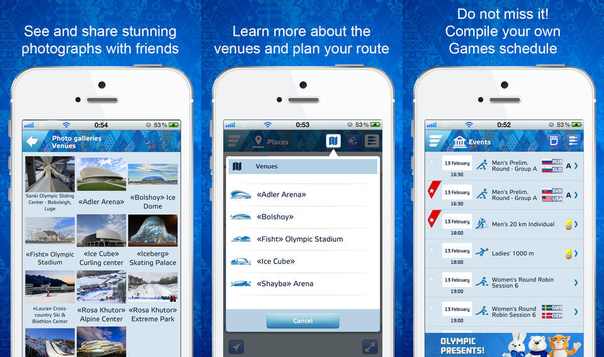
This guide is for visitors to the games in Sochi with a full schedule of events, including cultural ones, the location of sports facilities, the transport system, and the section on passing the Olympic / Paralympic torch relay. The application was specially optimized for visitors in roaming, so the initial data update, which can be downloaded at the hotel via wi-fi, contained the entire package of information available offline: from the schedule and description of objects to the transport schedule. Since the competitions were sometimes postponed, the application requested “delta” updates every hour and, if it was possible to receive it (the Internet is available), carried out a correction.
results

Actually the main application for viewers around the world with the schedule of competitions, the results in real time, information on athletes and medals. Available only in the mode of connecting to the Internet, as the information is updated every 10 seconds.
Both applications downloaded for all platforms more than 6 million people. The number of application launches exceeded 130 million.
There was no official detailed information on the platforms yet, therefore, unfortunately, I can’t tell you the exact numbers, but in general “Results” were 3 times more popular than “Guide”, iOS applications downloaded almost 2 times more than on Android or WP.
The most popular devices on the respective platforms (Android, iOS, WP, respectively) were:
1. Samsung Galaxy S3 (9%)
2. Samsung Galaxy S4 (6.5%)
3. Samsung Galaxy S4 Mini (3.4%)
1. iPhone 5 (23%)
2. iPhone 4S (19%)
3. iPhone 5S (12%)
1. Nokia Lumia 920 (17.5%)
2. Nokia Lumia 520 (14.5%)
3. Nokia Lumia 820 (9%)
Applications were much more popular in Russia than in other countries. And we confidently kept on the first positions in the stores since February 8.
Application Promotion
On promotion, I must say a big thank you to our marketers and stores, who have included the official applications of Sochi in the collection, which significantly influenced the growth in the number of downloads.
iTunes
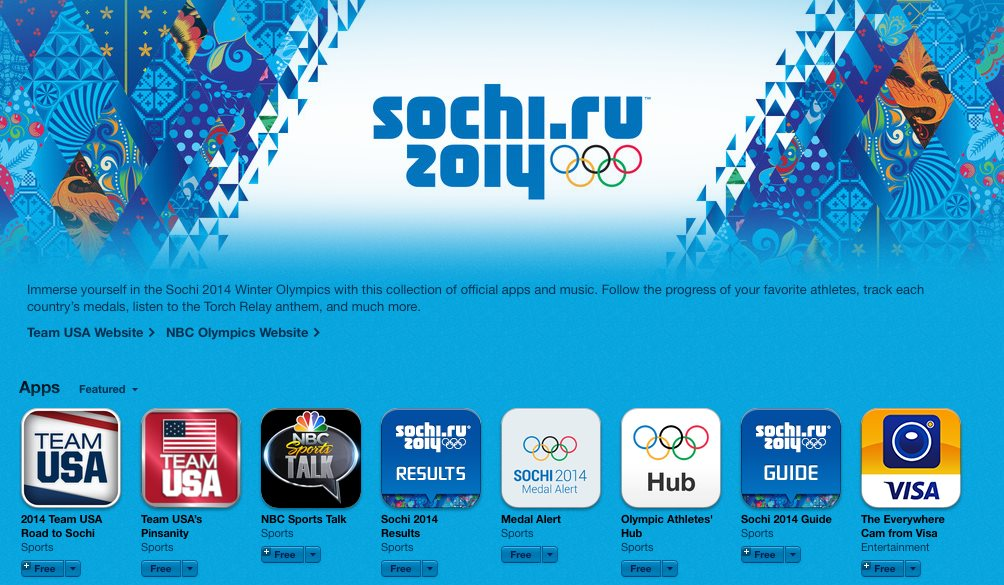
Google play

Windows phone store

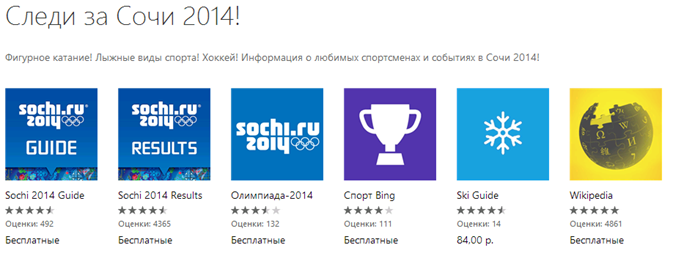
There were also banners on the official website and its subsections, including the ticket website, on-site posters in Sochi and Adler. In addition, the applications advertised each other in the built-in advertising system.
Microsoft, a partner of Games, provided not only the development of the entire backend of the official site, but also developed an API for both mobile applications, taking into account their different logic of receiving updates and work. Each update was first tested on the TEST environment, then switched to STAGING, and after the final check of mobile developers, it was deployed to PROD. This allowed for seamless collaboration and minimizing the number of conflicts.
The most interesting, of course, was the work on the application.
"Results"
In London 2012, competition screens for mobile applications were a “specially cut” version of the mobile version of the site and frankly, they were rather unstable, not providing a full-fledged transition either to the competition, or to the athlete, or to the country from the results screen.
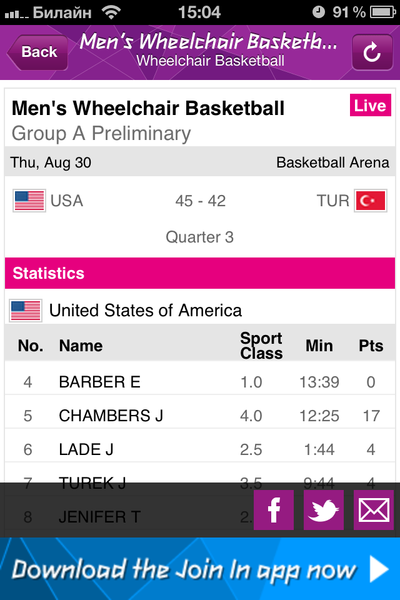
To make a significant leap in quality, it was decided to implement the results natively on each platform. Nativeness also made it possible to create personalized messages for posting on the social network and go to the athletes in the application, and not on the web page, as it was in London.

And of course, planning the use of window space has also been carefully worked out so that there are no situations where the main information occupies only 33% of the screen.
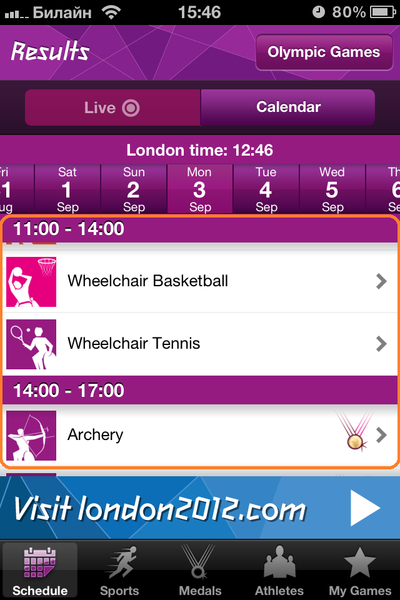
All data on the schedule, countries, athletes, results, medals are taken from the official source - Olympic Data Feed, which can be accessed for a fee in principle by any company. At this address, odf.olympictech.org, you can see CommonCodes specifications (common references) and detailed specifications for each sport discipline. Sport specifications cover approximately 100-150 pages and contain all basic information on all types of messages that come from the system. Here's an example for hockey - odf.olympictech.org/2014-Sochi/OG/PDF/ODF%20IH%20Data%20Dictionary.pdf
Messages come in XML format and work with them directly, given their "transactional" (that is, the summary information comes only every 5-10 minutes, mostly changes come) in mobile applications is not very convenient. Microsoft, together with its contractor, has created for us its own API based on these specifications, which allows us to obtain all the information necessary for a particular application screen at any time. The format is also "more enjoyable" - JSON. Of course, all requests with the server went only through GZIP.
Car and small truck results screens
Now more about the screens. To understand the scale of design, development and testing, imagine that 98 medals were played out in total, 381 competitions took place during the games, while 180 (one hundred and eighty!) Different screens of current results were to be implemented in mobile applications. The full “sheet” of design layouts for applications that were made for mobile applications by the same contractor as for the official site took 57 pages, 4 screens per page. Also, unlike London, a separate layout was made for the tablet, rather than a smartphone screen that opens to the right of 1/3 of the screen. Here I must say a big thank you to the designers and developers that they mastered all this.

In each sport there was "basic" and "detailed" information. The main consisted of lists of athletes with a bib (number), a country and a key result: time and difference, for example, or the number of points. Detailed information included almost everything that ODF could give us. For example, these are the types of planned and executed elements in figure skating or the chronology of events in hockey. Each screen existed in 3 locations: Russian, English and French.

And now we open additional information.

What exactly to display and in what order is clearly regulated by another document - ORIS (Olympic Results & Information Services). Based on it, we drew the design of results screens and infographics for the site and developed the design layouts for mobile application screens. To imagine this document in 400-500 pages, describing all types of situations of all phases of the competition, and there are several: before getting the start lists, after, after the start of the first participant, in the mode of the current competition, after the finish of the first participant, after the finish of all after receiving medals + necessary sorting + all types of behavior in case of disqualifications, DNS, DNF (that is, when the athlete did not start / did not finish). All this was necessary to comply. For example, the ORIS specification for freestyle takes 584 pages.
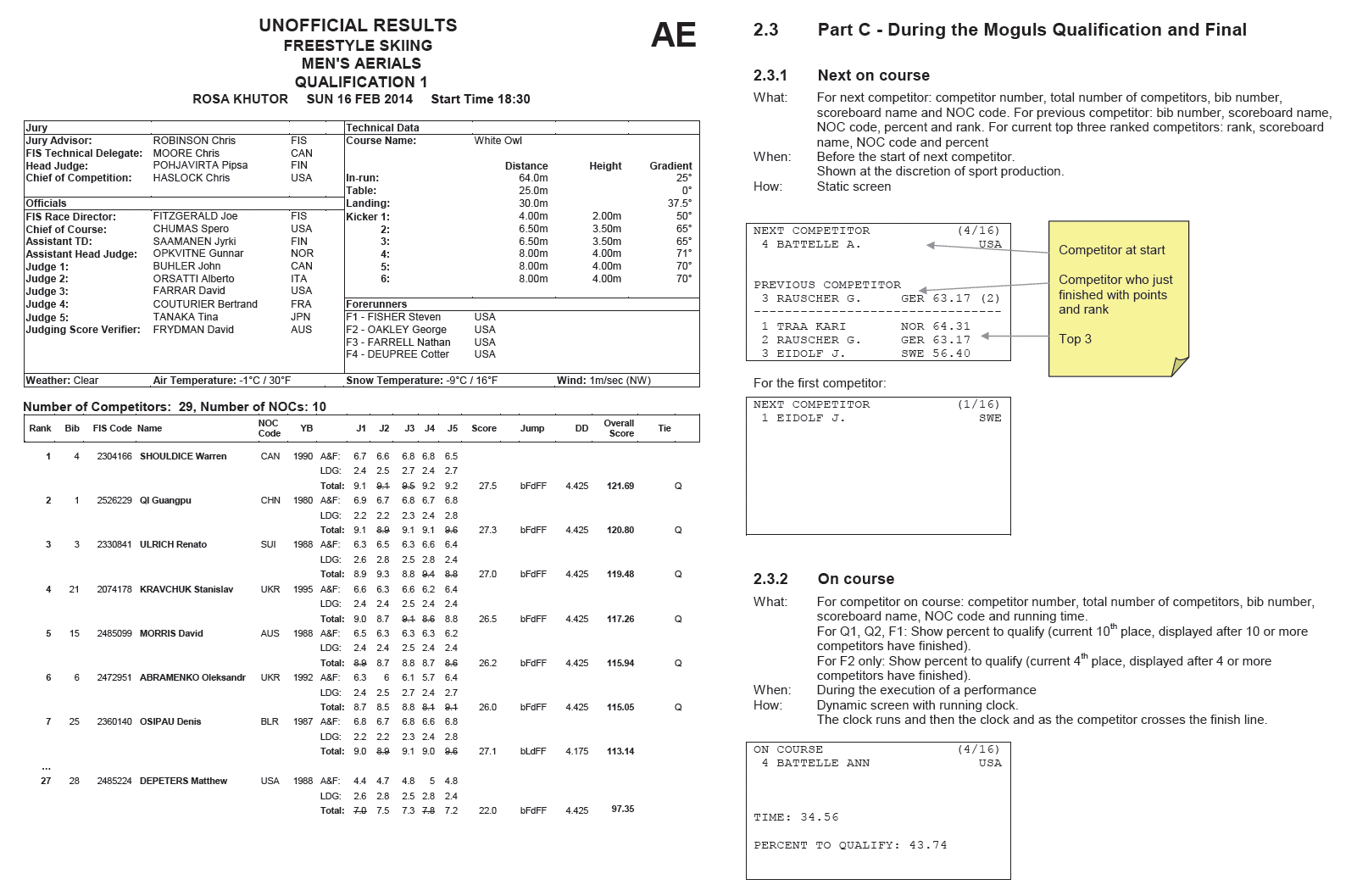
And if, for example, in most skis in most competitions, the view of the additional information screen almost coincides (only the number of segments and the presence / absence of speed changes), then the freestyle and snowboard spoiled a lot of blood, given that each competition is almost a completely different event, and in the snowboard cross even phases differ significantly (qualification goes according to one rules, finals - according to others). Everyone who was engaged in the development of results, I am sure, has already become a specialist in winter sports :)
In group sports (hockey and curling) tournament tables were also added, which required their own logic when receiving or not receiving certain messages.
Testing
Accordingly, the Venue Results Managers, who are actually responsible for generating messages for ODF, and sports managers, translators, communications, marketing, developers and project managers were involved in testing the site and applications. Systems were tested both during test real competitions, and with the help of coordinated and End-2-End-tests, when data were generated directly by the systems at the facility and passed through all systems up to output to the site and to the application, as well as in emulation mode. Accordingly, on all platforms each stage of the competition was tested, a screenshot was taken and a remark or successful passing the test for the PMI was recorded. I must say that PMI took from 50 to 100 pages depending on the sporting discipline.
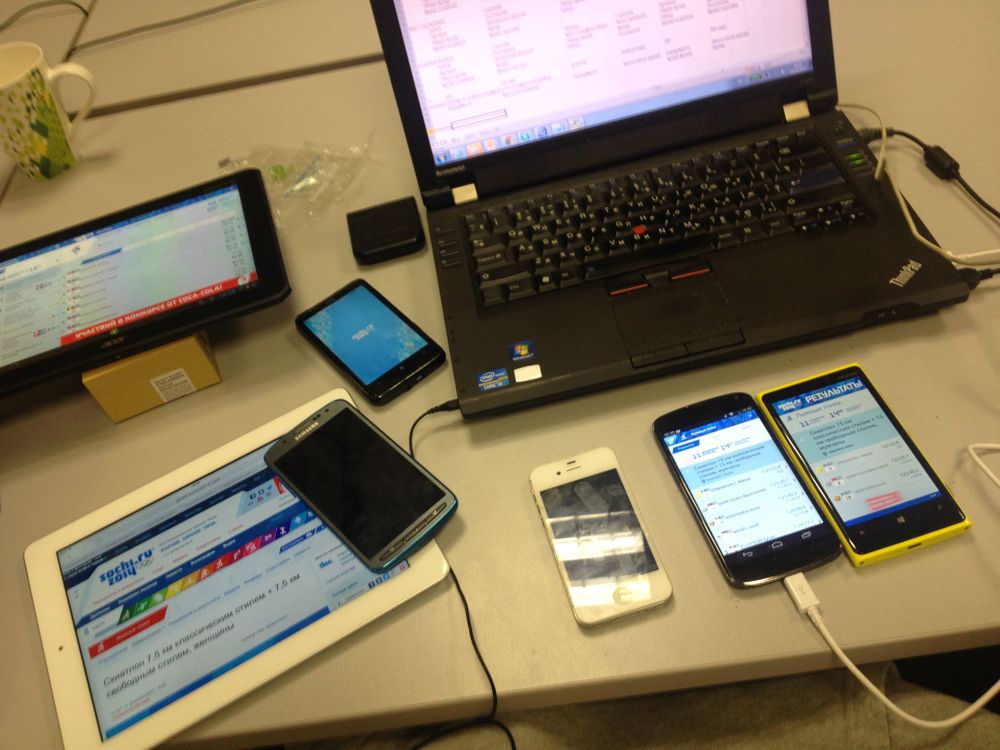
Pushes
Messages were also implemented much more interesting than in London.
When we received a message about medals (we reported only official information, that is, after the competition was fully completed and the flower ceremony started), push was generated to all platforms in 3 languages and sent to devices depending on user settings.
Again, the native results made it possible to realize not only medal push messages (as was the case in London), but also push with the current results of selected sports disciplines and athletes. That is, in hockey came the score of matches, and for the chosen athlete - his result in the completed competition. It was especially nice to see that even with a rather heavy load, the push came 2-3 minutes ahead of other medal applications.
And of course, at the end of the Olympic Games, it was especially nice to receive push-messages about the athletes of the Russian national team.
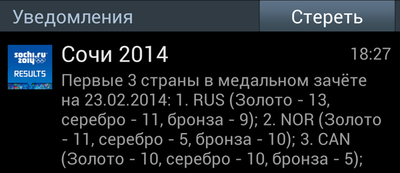
Technical support
Technical support during the Games was provided 24x7 by 37 specialists in several roles responsible for their area: from ODF processing to the client side of applications.
Here’s something like “watching a match”

In general, during the Olympic Games, the number of incidents (including requests for change) was at least 3 times less than in London.
Megafon’s partner at the Games’s specialists, who were actually responsible for developing the client side of the mobile application, checked hourly the performance of the main sections of the application, as well as monitored the application’s reviews in the stores, crashes sent to the analytical system and the messages sent to the e-mail support and formed the corresponding tasks to developers.
Results
The result, in my opinion, can and should be proud of. Results in mobile applications and on the site often appeared earlier than on the stadium scoreboard, not to mention the TV broadcasts. Here the results were updated in our 5th second, and on the scoreboard - on the 15th:
The application received high marks, all the Olympic Games were held in the first places in the ranks and were downloaded more than 1 million times on each platform. In all appstores, the average rating was above 4.5, which, given the huge audience and despite the traditional “I will not watch your Olympiad, here’s a unit for you” is a great result.
The most popular section ceased to be the “medals” section (as it was in London, people just came to see the medal standings), and became the “Schedule and Results”, in which users followed events online. The most popular, of course, were figure skating and biathlon (and in fact there could be hockey ...). The ratings and reviews of people in the stores and on e-mail technical support were often very encouraging, even when it was very difficult:
- Application on a solid 5. Everything is clear, quickly and briefly. If necessary, it is possible and not short, in detail. The athlete wins the medal and in 5-10 seconds the notification comes. Thanks to the creators and serving applications :)
- Indispensable for fans in the thick of things! It helps and Swallow not be late and the results of the competition is not to miss)
- The best application on this platform, design and usability is thought out in and out. I feel with her that the Olympic Games are near, even though I am thousands of miles away. I can track athletes, competitions in specific sports. It's hard to miss something. I hope that there will be the same program for every game! Cheers to the creators!
- To coin the sochi phrase would be true. Easy to set up, easy to use, no crashes or bugs. Just wonderful. TV books are rubbish. Definitely recommend this app!
- A must have app if your in Sochi or at home. Smooth, real time results (sometimes it could be seen on TV.), It doesn't crash. Anyone that gives it a phone or a technologically illiterate.
And of course it was much nicer just to see people in Sochi who use your applications.
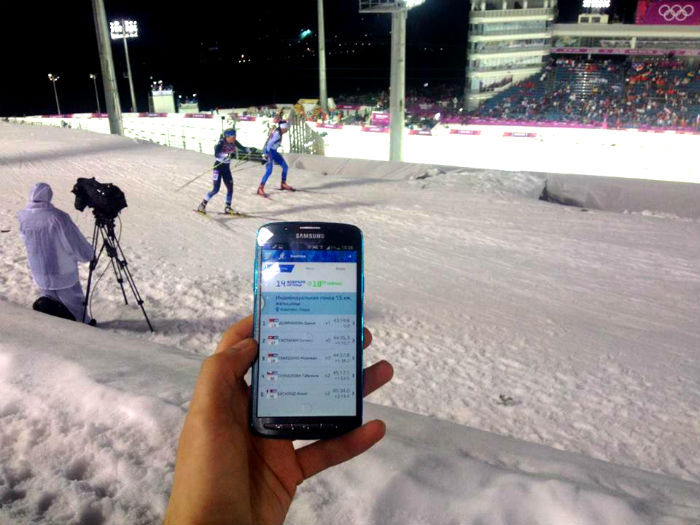
There is still a lot of work ahead, including updating the Guide and Results apps for the Paralympic Games.
It was hard, but very cool. Stay with us.
Source: https://habr.com/ru/post/214777/
All Articles